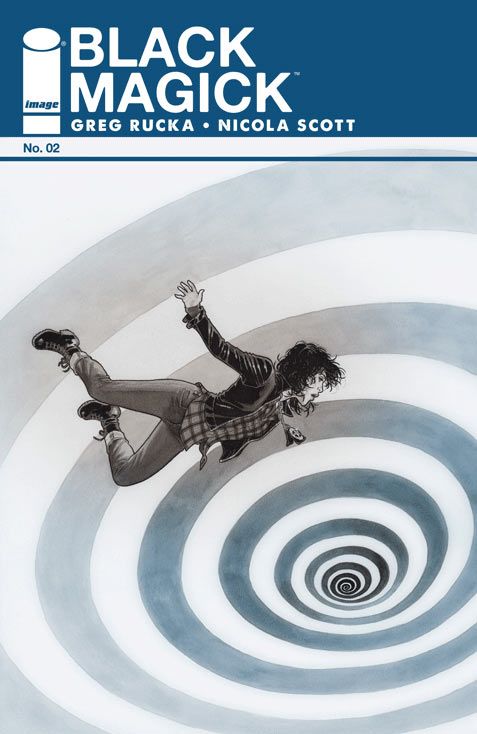Compared to the debut issue, "Black Magick" #2 by Greg Rucka and Nicola Scott is much sleepier. There are no coven meetings in the woods, no hostage situation, no attempted murders, no fire, no displays of magick. The first issue focused on making a first impression with lots of dramatic action, but the second concentrates more on characterization and suspense.
The lead-in is almost boring as Rowan's boss gives the department's morning briefing, but then Rucka smoothly segues into the first of three related subplots. There's situational irony in how Rowan has to face a good cop, bad cop routine when she has to visit Inspectors Prestes and Bellowes in the Internal Affairs Bureau. Bellowes' questions indicate suspicion and hostility, and Scott's body language and facial expressions for him amplify the tension in the air. Unbeknownst to the I.A.B. or any other police, Rowan had to kill a man in self-defense, and Scott's facial expressions also telegraph Rowan's feelings of fear, anger, dread, guilt and worry.
The next scene -- in which Rowan debriefs Alex, a fellow witch and probably her coven leader -- has similarly smooth world building and exposition. The guy who tried to kill Rowan in the first issue referred to people who "did" things to him and, through dialogue, Rucka spells out the twist: not only are witch hunters back, but their methods may have changed. I like how Rucka and Scott take their iconography from history. The hammer symbol can only refer to "Malleus Maleficarum," the infamous medieval treatises on witches.
The last plot thread, a new homicide case for Rowan and her partner Morgan, seems unrelated to Rowan's unwanted collision of her witchcraft activities and her day job. Of course, it is related, and Scott makes that point clear with a rare use of color for the murder victim's hand.
The choice to make "Black Magick" mostly black and white hasn't detracted from its realism. Rucka's dialogue is strong enough to make every character feel believable and human. The lack of color also makes it easier to focus on the details of Scott's painterly artwork, particularly changes in faces and bodies. It also gives the story a hushed quality and makes the gorier scene at the end feel less lurid. The only time I wished there was color was in the scene in which Rowan met with Alex. The background details, like the chairs, were lovely and the bright daylight-lit tableau would have benefited the most from full color. It's amazing how Scott gets across the feeling of sunlight with shading, clothing choices and the flight of a passing bird. She has designed distinctive, detailed features for all the characters; the close-up of Alex's face made me wonder about the color of people's eyes.
Rucka's back matter is always worth the attention, and the second installment of a written narrative of one Gilles Robert du Pont-l'Évêque in the 16th century has some excellent prose, showing a young man's moral and intellectual coming-of-age through his questioning of his family's mission and beliefs.
The themes of "Black Magick" are eternally compelling: secrecy, a double life, power, sex, good and evil, life and death. Rucka's fusion of a police procedural and an old occult/religious power struggle feels sharp and well-constructed, and Scott's artwork is a perfect partner to the pacing and character development. If the rest of the opening arc is just as strong, "Black Magick" will easily be one of the best new titles of 2015.

